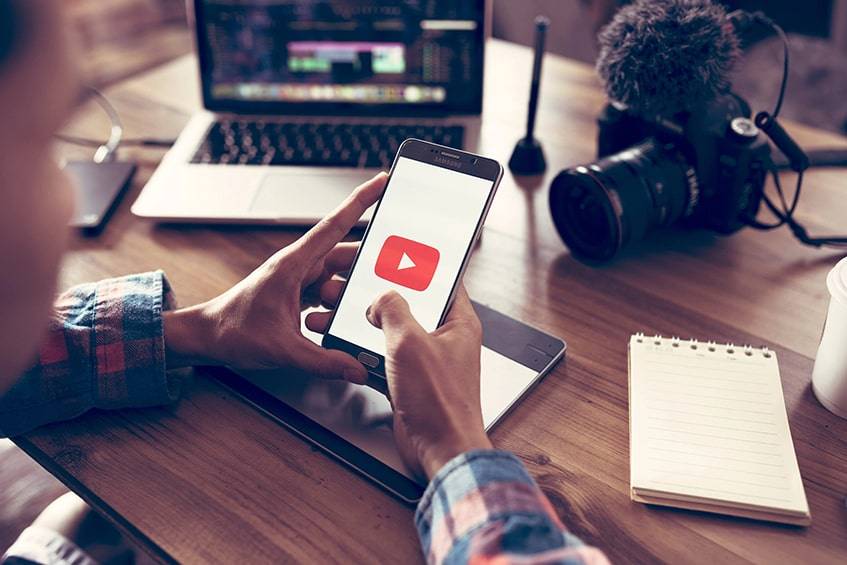YouTube is a gold mine for businesses and influencers. Some people see this website as an entertainment hub. Yet, the platform is a great place to grow a side hustle or manage a company. Others might not realize that it’s the second-largest search engine behind Google.
It helps brands engage with more customers from around the world. Individuals and teams can market products and services through videos. A YouTube brand account is different from a personal profile. This guide will explain everything entrepreneurs need to know.
Table of Contents
What is a Brand Account on YouTube?

The first question is, what is a brand account on YouTube? It’s a company profile that displays the brand’s icon and related content. Individuals can manage the profile through a personal YouTube account. Yet, all the entrepreneurial marketing and content go on the brand channel.
Most companies consider this the social media management team. Together, the group works to boost brand awareness.
This platform is still as popular as ever in 2023, so it’s a good idea to join. The next section will explain how to create a company profile on YouTube.
How to Create a Brand Account on YouTube

A brand account on YouTube can help teams establish a business. In fact, that’s one of the defining characteristics. As opposed to an individual profile, this one has a policy that allows multiple managers. For those who don’t have one yet, here’s how to create a brand account on YouTube.
- The first step is to log in to a personal YouTube profile. If they don’t have one, they need to sign up. It’s as easy as registering with a Google email address.
- Next, they click on their user icon in the top-right corner.
- A drop-down menu will appear, and they can click on “Creator Studio.”
- Then, they go to their user icon again. This time, they select “Settings” and choose “Create a New Channel.”
- They have to come up with a name for the business profile. It should be recognizable and match with their other social media accounts.
- Finally, they click “Save”, and that’s it.
The individuals who make the channel are the account managers. They can switch between the business and personal profiles anytime. The dashboard is the central place where they can manage everything. After 30 days, administrators can make a custom URL for the company channel.
Adding Brand Account Managers

It’s easier to manage a YouTube profile when there are several administrators. That way, the team can work together, and no one gets overwhelmed. The result is more videos and engaging content for the audience. Remember that business channels can have more than one manager. Personal ones can’t.
This includes
- editing channel information,
- posting videos,
- replying to comments.
If he or she needs help, they can grant these abilities to other administrators. The only task the other managers can’t do is add or remove administrators.
It’s a good idea to make the team lead the top manager. He or she already has a leadership role, so they’re a good match for this position.
How to Assign Managers
Once the first administrator is set up, they can add more managers. All the new people must have a Google profile. Otherwise, they can’t log in to YouTube. Here’s how to add to the management team.
- The top administrator must log in to their Google profile. Then, they can sign in to YouTube. This will take them to their personal channel.
- They need to click the user avatar in the top-right corner. Then, select the “Switch account” from the drop-down menu.
- He or she will choose the brand profile from the list.
- Next, they can go to the channel avatar again. This time, it will be the brand’s icon, not the personal one.
- The drop-down menu will appear. The administrator will click “Settings.”
- From there, he or she chooses the “Managers” section. There will be a gray box that says, “Add or remove managers.”
- They select this option and then choose “Manage Permissions.”
- Next, they go to the “Invite new users” button in the top-right corner. They have to type in the new manager’s Google email address.
This individual will receive a message inviting them to join the channel. The administrator can repeat this process to add any other people.
Customizing a YouTube Brand Account
Now comes the fun part. It’s time to add some flair to the YouTube brand account. This is how the team can differentiate themselves. It helps to build a brand identity, too. There are a few sections to consider, so follow these steps below.
Channel Description
This section is important because it lets visitors know what to expect. The description is like a company blurb. It’s a quick way for others to learn about the channel.
- The first step is to go to the account page.
- Next, hit the blue button that says “Customize.” This redirects to another page.
- There are a few tabs here. Select the “About” one.
- In this section, people can add a brand description. This might include the location, contact email, or telephone number. It’s a good idea to add the company’s social media links, too.
- If the business has a website, then use the description from there. This keeps things consistent. Be sure to include the vision or mission statement and values. What does the company do? Who do they serve, and why?
- Another tip is to type in some keywords related to the enterprise or industry. It will help other users find the channel or its content.
- Under the description section, there are other buttons. One says, “Email.” This is for business inquiries. Another one says, “Location.” It’s fine to leave that info out of the description. It will keep things concise.
- The last section is for social media links. Some people like to put these in the description, too. It’s a matter of preference.
Including all these details will provide a great general overview. It doesn’t take too long to complete these sections, so don’t put them off.
Featured Channels
To the right side, there is a “Featured Channels” section. This is where administrators can add any other accounts. These should be profiles that they manage or own. In other words, it’s not a place to feature friends.
On the other hand, the company may work with other influencers. In that case, they can add those channels to this list. It’s a good way to build connections on the platform.
Channel Icon & Art
Here’s another fun way to add customization. Check out the main differences between channel icons and art below.
The Icon
The icon is like a logo. It helps companies stand out from the rest. Plus, a professional logo adds credibility. Influencers use logos in the bottom corner of their videos. It’s a quick way to mark their content. This asset should match the profile picture. Typically, the dimensions are 800px by 800px.
The Cover Art
The cover art (or banner) adds personality and visual engagement. It makes the channel more inviting and easier for visitors to remember. The typical size is 2560px by 1140px.
Channel Trailer
When someone visits a YouTube page, they might see a trailer. These videos serve as a great introduction. They’re like a visual and interactive “About” section. This is a chance to promote the company, it’s products or services, and the team. Also, the trailer should explain how viewers or subscribers benefit.
Channel URL
A custom URL is another way to add credibility. A YouTube brand account needs one of these in 2023. Yet, there are requirements to consider:
- The channel should be at least 30 days old
- It needs over 100 subscribers
- There must be an icon and channel art (banner)
Channel Links
Finally, a YouTube brand account needs to list these links. It’s a way for visitors to access the brand’s social media profiles. This section can also include the company website. Links connect the wider community and open more doors. Include these to increase awareness and engagement with the audience.
Transitioning a Personal Channel to a YouTube Brand Account

Some influencers may want to move their first channel to an existing YouTube brand account. They can only do this if they registered the business account with their Google email. The steps below show how to transition to a company channel. When this happens, all the content from the first profile automatically transfers.
Here’s how to do it.
- First, individuals sign in to their YT profile. The log-in button is in the top-right corner of the website.
- Next, he or she selects the user avatar. It’s in the same place. From the drop-down menu, they choose “Settings.”
- Then, he or she goes to the Overview section. There’s an option that says, “See all my channels or create a new channel.”
- When they pick this option, they can see all their managed accounts.
- Those who don’t have a company channel yet should select “Create a new channel.”
- Follow the earlier steps in the “How to Make a Brand Account on YouTube” section in this guide.
- Add the final details and save everything.
- Next, go to the settings menu on the brand account. Choose the “Advanced” category.
- In this section, there’s an option that says,”Move your channel to Brand Account.” Hit that link, followed by the “Select desired account.”
- Highlight the company profile and then hit the blue “Move channel” button.
- A pop-up menu will appear that says, “Use YouTube as…”. Highlight the Brand Account option.
- Finally, make sure the company channel looks correct.
Teams may want to have several administrators. In that case, they must repeat this process for each person.
Pros & Cons of Brand Channels on YouTube

Social media is a must-have for companies in 2023. Sites like Facebook and Instagram have business pages and profiles. A brand account on
YouTube provides a platform for sharing content with a wider audience.
This is great, but there are a few things to keep in mind. Check out the benefits and setbacks of this strategy below.
Pros:
1. Boost engagement. Teams can get more views by sharing more product and service content. Videos are more interactive and get consumers excited. They can see the company and team in action. This is one of the best marketing strategies. It also appeals to all industries and niches. Best of all, logging in is easy, thanks to Google accounts.
2. Easier to manage. A YouTube brand account is a team effort. The channel can have several administrators, so no one feels overworked. Different group members can add engaging content throughout the week. This keeps everything fresh, and the audience won’t get bored.
3. More earning potential. There are more collaboration opportunities on this platform. It’s a lot of fun for subscribers to see their favorite YouTubers working together. It also brings more views and comments on the channel. This paves the way for more brand awareness and higher sales.
4. Deeper insights. YouTube analytics and related tools are good for tracking metrics. Marketers can gather useful measurements like views, comments, and subscribers.
5. Better cross-promotion Finally, this platform can help teams reach more users across the Web. Be aware that there are strict policy rules about this. Yet, it still provides a way to share content across different profiles. Companies can post links to their videos on Facebook, Twitter, and Instagram. They can also direct their viewers to other social media.
Cons:
1. Oversaturation. One disadvantage is that this platform is one of the most crowded. It takes time for influencers to build a following. Of course, it helps if they already have fans on other social media. Still, don’t expect tons of video views right away.
2. Competitiveness. The algorithm draws lots of competition. When someone views a video, YouTube starts recommending similar channels. This is a great policy for the consumer, but not so much for influencers. They need to keep their content fresh and exciting. That’s the only way to keep people coming back for more.
FAQs
What is the Difference Between Personal and Business YouTube Accounts?
At first glance, these two profiles seem to have a lot in common. Yet, there are specific differences.
- A personal account is what everyone uses to watch videos on the platform. They don’t have to post any content to enjoy these services.
- A brand account is specifically for business purposes. Unlike an individual profile, a company channel can have several administrators.
Is a YouTube Brand Account Free?
Yes. People don’t have to pay anything to have this type of profile. Yet, there are paid tools that they can try. There are services for keywords, tags, and monetizing content. It can be worth the investment because more followers will come to the channel.
What’s the Difference Between a YouTube Account and Channel?
The former is the email address that people use to access their G Suite apps. That includes things like Gmail, Drive, and Sheets. They also use this email to log in to YouTube. The latter is that person’s content, if they have any. This would be a collection of videos and community posts.
Can I Monetize My Brand Account?
Yes, and a lot of influencers do this. It’s a fun way to earn extra income. Before starting, people should know that not every channel can be monetized.
There are a few requirements:
- 10,000 views
- 4,000 watch hours
- 1,000 subscribers
Those that meet these standards can monetize through AdSense. Other ways to earn money include sponsorships, YouTube Red, and selling merchandise.
Try YouTube for Better Brand Awareness
This platform isn’t going anywhere in 2023 or beyond. More than a billion people use the site, so there’s always an audience. Plus, companies report over 150% growth from posting video content. There’s no doubt that this is a great way to spread the word and reach more people.
If you have experience with a brand or influencer channel, let us know in the comments. Tell us about the struggles, benefits, and any tips you have.

Comments